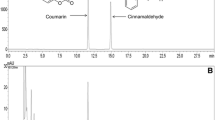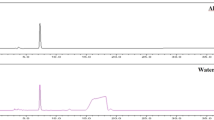Abstract
Ochratoxin A (OTA), a mycotoxin produced by several Aspergillus and Penicillium species, is a worldwide contaminant of food and feedstuffs. It is nephrotoxic, immunosuppressive and carcinogenic in several animal species. The mechanism by which OTA acts is not fully understood up to now. Here, OTA was evaluated for mutagenicity in the Salmonella typhimurium assay (Ames assay) and in the HPRT assay with V79 hamster fibroblasts. In the bacterial assay using the strains TA 98, TA 100, TA 1535, TA 1538, TA 102 and TA 104, OTA was not mutagenic at a concentration range from 0.01 to 500 µM in the presence and absence of an external metabolising enzyme system (rat liver S9 enzyme mix). In V79 fibroblasts, cytotoxicity of OTA was estimated with the neutral red uptake assay. An IC50 of 11.6 µM was found in the absence and an IC50 of 6.4 µM in the presence of S9 mix. In the subsequent HPRT (hypoxanthine-guanine-phosphoribosyl-transferase) assay with V79 cells the negative result of the bacterial assay was confirmed using OTA in concentrations from 0.1 to 100 µM. In order to obtain converted OTA metabolites from viable, metabolically competent cells, a preincubation of primary cultured rat hepatocytes with 0.016 to 0.8 µM OTA was performed. The resulting culture medium, which contained OTA metabolites, was tested in both mutagenicity assays. Again, no mutagenic effect was detected either in the bacterial or in the mammalian test assay. In accordance with several literature data, the present results imply that OTA does not act as direct mutagen. Additionally, the OTA metabolites derived from cultured rat hepatocytes or rat liver S9 mix, also, do not have a mutagenic potency in the test systems used.



Similar content being viewed by others
References
Aleo, MD, Wyatt RD, Schnellmann RG (1991) Mitochondrial dysfunction is an early event in ochratoxin A but not in oosporein toxicity to rat renal proximal tubules. Toxicol Appl Pharmacol 107:73–80
Babich H, Borenfreund E (1992) Neutral red assay for toxicology in vitro. In: Watson RR (ed) In vitro methods of toxicology. CRC Press, Boca Raton, pp 237–251
Bendele AM, Neal SB, Oberly TJ, Thompson CZ, Bewsey BJ, Hill LE, Rexroat MA, Carlton WW, Probst GS (1985) Evaluation of ochratoxin A for mutagenicity in a battery of bacterial and mammalian cell assays. Food Chem Toxicol 23:911–918
Benford D, Boyle C, Dekant W, Fuchs R, Gaylor DW, Hard G, McGregor DB, Pitt JI, Plestina R, Shephard G, Solfrizzo M, Verger PJP, Walker R (2001) Ochratoxin A. In: Safety evaluations of certain mycotoxins in food, WHO Food Additives Series 47, FAO Food and Nutrition Paper 74. IPCS International Programme on Chemical Safety, WHO, Geneva, pp 281–387
Castegnaro M, Chernozemsky IH, Hietanen E, Bartsch H (1990) Are mycotoxins risk factors for endemic nephropathy and associated urothelial cancers? Arch Geschwulstforsch 60:295–303
Dörrenhaus A, Föllmann W (1997) Effects of ochratoxin A on DNA repair in cultures of rat hepatocytes and porcine urinary bladder epithelial cells. Arch Toxicol 71:709–713
Eder S, Benesic A, Freudinger R, Engert J, Schwerdt G, Drumm K, Gekle M (2000) Nephritogenic ochratoxin A interferes with mitochondrial function and pH homeostasis in immortalized human kidney epithelial cells. Pflügers Arch 440:521–529
Föllmann W, Petzinger E, Kinne RKH (1990) Alterations of bile acid and bumetanide uptake during culturing of rat hepatocytes. Am J Physiol 258:C700–C712
Gautier JC, Richoz J, Welti DH, Marcovik J, Gremaud E, Guengerich FP, Turesky RJ (2001) Metabolism of ochratoxin A: absence of formation of genotoxic derivatives by human and rat enzymes. Chem Res Toxicol 14:34–45
Gekle M, Schwerdt G, Freudinger R, Mildenberger S, Wilflingseder D, Pollack V, Dander M, Schramek H (2000) Ochratoxin A induces JNK activation and apoptosis in MDCK-C7 cells at nanomolar concentrations. J Pharmacol Exp Ther 293:837–844
Grosse Y, Baudrimont I, Castegnaro M, Betbeder A-M, Creppy EE, Dirheimer G, Pfohl-Leszkowicz A (1995a) Formation of ochratoxin A metabolites and DNA-adducts in monkey kidney cells. Chem Biol Interact 95:175–187
Grosse Y, Castegnaro M, Mace K, Bartsch H, Mohr U, Dirheimer G, Pinelli E, Pfeifer A, Pfohl-Leszkowicz A (1995b) Cytochrome P-450 isoforms implicated in ochratoxin A genotoxicity determined by DNA adduct formation. Clin Chem 41:1927–1929
Gross-Steinmeyer K, Weymann J, Hege H-G, Metzler M (2002) Metabolism and lack of DNA reactivity of the mycotoxin ochratoxin A in cultured rat and human primary hepatocytes. J Agric Food Chem 50:938–945
Hagelberg S, Hult K (1989) Toxicokinetics of ochratoxin A in several species and its plasma-binding properties. J Appl Toxicol 9:91–96
Henning A, Fink-Gremmels J, Leistner L (1991) Mutagenicity and effects of ochratoxin A on the frequency of sister chromatid exchanges after metabolic activation. In: Castegnaro M, Plestina R, Dirheimer G, Chernozemsky IN, Bartsch H (eds) Mycotoxins, endemic nephropathy and urinary tract tumors, IARC Scientific Publications vol 115. International Agency for Research in Cancer, Lyon, pp 255–260
IARC (1993) Some naturally occurring substances: food items and constituents, heterocyclic aromatic amines and mycotoxins. In: Monographs on the evaluation of the cancinogenic risk of chemicals to humans, vol 56. International Agency for Research on Cancer, Lyon, pp 489–519
Lebrun S, Follmann W (2002) Detection of ochratoxin A-induced DNA damage in MDCK cells by alkaline single cell gel electrophoresis (comet assay). Arch Toxicol 75:734-741
Maron DM, Ames BN (1983) Revised methods for the Salmonella mutagenicity test. Mutat Res 113:173–215
Nestmann ER, Brillinger RL, Gilman JPW, Rudd CJ, Swierenga SHH (1991) II. Mutation in chinese hamster ovary, V79 chinese hamster lung and L5178Y mouse lymphoma cells. Mutat Res 246:255–284
Obrecht-Pflumio S, Dirheimer G (1997) In vitro DNA and nucleotides adduct formation caused by ochratoxin A. Mutat Res Suppl 1:156
Obrecht-Pflumio S, Dirheimer G (2000) In vitro DNA and dGMP adducts formation caused by ochratoxin A. Chem Biol Interact 127:29–44
Obrecht-Pflumio S, Chassat T, Dirheimer G, Marzin D (1999) Genotoxicity of ochratoxin A by Salmonella mutagenicity test after bioactivation by mouse kidney microsomes. Mutat Res 446:95–102
Petkova-Bocharova T, Castegnaro M (1991) Ochratoxin A in human blood in relation to Balkan endemic nephropathy and urinary tract tumours in Bulgaria. In: Castegnaro M, Plestina R, Dirheimer G, Chernozemsky IN, Bartsch H (eds) Mycotoxins, endemic nephropathy and urinary tract tumors, IARC Scientific Publications vol 115. International Agency for Research on Cancer, Lyon, pp 135–137
Pfohl-Leszkowicz A, Chakor K, Creppy EE, Dirheimer G (1991) DNA adduct formation in mice treated with ochratoxin A. In: Castegnaro M, Plestina R, Dirheimer G, Chernozemsky IN, Bartsch H (eds) Mycotoxins, endemic nephropathy and urinary tract tumors, IARC Scientific Publications vol 115. International Agency for Research on Cancer, Lyon, pp 245-253
Pfohl-Leszkowicz A, Grosse Y, Kane A, Creppy EE, Dirheimer G (1993) Differential DNA adduct formation and disappearance in three mouse tissues after treatment with the mycotoxin ochratoxin A. Mutat Res 289:265-273
Pfohl-Leszkowicz A, Pinelli E, Bartsch H, Mohr U, Castegnaro M (1998) Sex- and strain-specific expression of cytochrome P450s in ochratoxin A-induced genotoxicity and carcinogenicity in rats. Mol Carcinog 23:76-85
Sauvant C, Silbernagl S, Gekle M (1998) Exposure to ochratoxin A impairs organic anion transport in proximal-tubule-derived opossum kidney cells. J Pharmacol Exp Ther 287:13–20
Schlatter C, Studer-Rohr I, Rasonyi T (1996) Carcinogenicity and kinetic aspects of ochratoxin A. Food Addit Contam 13:43–44
Schwerdt G, Freudinger R, Mildenberger S, Silbernagl S, Gekle M (1999) The nephrotoxin ochratoxin A induces apoptosis in cultured human proximal tubule cells. Cell Biol Toxicol 15:405–415
SCOOP Report (1996) Assessment of dietary intake of ochratoxin A by the population of EU Member States. European Commission Directorate General III, Brussels
Sostaric B, Vukelic M (1991) Characteristics of urinary tract tumours in the area of Balkan endemic nephropathy in Croatia. In: Castegnaro M, Plestina R, Dirheimer G, Chernozemsky IN, Bartsch H (eds) Mycotoxins, endemic nephropathy and urinary tract tumors, IARC Scientific Publications vol 115. International Agency on Research on Cancer, Lyon, pp 29–35
Speijers GJA, van Egmond HP (1993) Worldwide ochratoxin A levels in food and feeds. In: Creppy EE, Categnaro M, Dirheimer G, (eds) Human ochratoxicosis and related pathologies. Colloque INSERM, no. 231. J Libbey Eurotext, Montrouge, pp. 85–100
Stoev SD (1998) The role of ochratoxin A as a possible cause of Balkan endemic nephropathy and its risk evaluation. Vet Hum Toxicol 40:352–360
Wehner FC, Thiel PG, van Rensburg, Demasius IP (1978) Mutagenicity of Salmonella typhimurium of some Aspergillus and Penicillium mycotoxins. Mutat Res 58:193–203
Würgler FE, Friederich U, Schlatter J (1991) Lack of mutagenicity of ochratoxin A and B, patulin and cnestine in Salmonella typhimurium TA 102. Mutat Res 261:209–216
Zepnik H, Pahler A, Schauer U, and Dekant W (2001) Ochratoxin A-induced tumor formation: is there a role of reactive ochratoxin A metabolites? Toxicol Sci 59:59–67
Acknowledgements
Special thanks are due to Dr Klaus Golka for his careful reading of the manuscript and his constructive criticism. Thanks go to Ingrid Ester for her excellent technical assistance.
Author information
Authors and Affiliations
Corresponding author
Rights and permissions
About this article
Cite this article
Föllmann, W., Lucas, S. Effects of the mycotoxin ochratoxin A in a bacterial and a mammalian in vitro mutagenicity test system. Arch Toxicol 77, 298–304 (2003). https://doi.org/10.1007/s00204-002-0423-x
Received:
Accepted:
Published:
Issue Date:
DOI: https://doi.org/10.1007/s00204-002-0423-x




